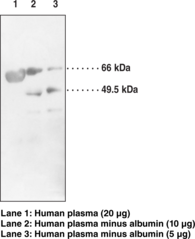Cayman
Showing 27151–27300 of 45550 results
-
The latrunculins are commonly used to experimentally disrupt the actin cytoskeleton of cells. Latrunculin B causes concentration-dependent changes in cell shape and actin organization. It sequesters G-actin and prevents F-actin assembly. It binds monomeric actin with 1:1 stoichiometry and can be used to block actin polymerization both in vitro and in cells (Kd = 60 nM).{16723} The short-term effects of latrunculin B are comparable to those of latrunculin A, although latrunculin B is slightly less potent.{16724} However, latrunculin B is gradually inactivated by serum so that induced changes are transient in the continued presence of the compound. For this reason, latrunculin B may have fewer unwanted effects than latrunculin A and may be preferred for short-term studies.
Brand:CaymanSKU:10010631 - 100 µgAvailable on backorder
The latrunculins are commonly used to experimentally disrupt the actin cytoskeleton of cells. Latrunculin B causes concentration-dependent changes in cell shape and actin organization. It sequesters G-actin and prevents F-actin assembly. It binds monomeric actin with 1:1 stoichiometry and can be used to block actin polymerization both in vitro and in cells (Kd = 60 nM).{16723} The short-term effects of latrunculin B are comparable to those of latrunculin A, although latrunculin B is slightly less potent.{16724} However, latrunculin B is gradually inactivated by serum so that induced changes are transient in the continued presence of the compound. For this reason, latrunculin B may have fewer unwanted effects than latrunculin A and may be preferred for short-term studies.
Brand:CaymanSKU:10010631 - 250 µgAvailable on backorder
The latrunculins are commonly used to experimentally disrupt the actin cytoskeleton of cells. Latrunculin B causes concentration-dependent changes in cell shape and actin organization. It sequesters G-actin and prevents F-actin assembly. It binds monomeric actin with 1:1 stoichiometry and can be used to block actin polymerization both in vitro and in cells (Kd = 60 nM).{16723} The short-term effects of latrunculin B are comparable to those of latrunculin A, although latrunculin B is slightly less potent.{16724} However, latrunculin B is gradually inactivated by serum so that induced changes are transient in the continued presence of the compound. For this reason, latrunculin B may have fewer unwanted effects than latrunculin A and may be preferred for short-term studies.
Brand:CaymanSKU:10010631 - 50 µgAvailable on backorder
The latrunculins are commonly used to experimentally disrupt the actin cytoskeleton of cells. Latrunculin B causes concentration-dependent changes in cell shape and actin organization. It sequesters G-actin and prevents F-actin assembly. It binds monomeric actin with 1:1 stoichiometry and can be used to block actin polymerization both in vitro and in cells (Kd = 60 nM).{16723} The short-term effects of latrunculin B are comparable to those of latrunculin A, although latrunculin B is slightly less potent.{16724} However, latrunculin B is gradually inactivated by serum so that induced changes are transient in the continued presence of the compound. For this reason, latrunculin B may have fewer unwanted effects than latrunculin A and may be preferred for short-term studies.
Brand:CaymanSKU:10010631 - 500 µgAvailable on backorder
LAU159 is a positive allosteric modulator (PAM) of α6β3γ2 subunit-containing GABAA receptors.{52055} It selectively increases GABA-induced currents in X. laevis oocytes expressing α6β3γ2 over α1β3γ2, α2β3γ2, α3β3γ2, α4β3γ2, and α5β3γ2 subunit-containing receptors at 10 μM.
Brand:CaymanSKU:26336 - 1 mgAvailable on backorder
LAU159 is a positive allosteric modulator (PAM) of α6β3γ2 subunit-containing GABAA receptors.{52055} It selectively increases GABA-induced currents in X. laevis oocytes expressing α6β3γ2 over α1β3γ2, α2β3γ2, α3β3γ2, α4β3γ2, and α5β3γ2 subunit-containing receptors at 10 μM.
Brand:CaymanSKU:26336 - 10 mgAvailable on backorder
LAU159 is a positive allosteric modulator (PAM) of α6β3γ2 subunit-containing GABAA receptors.{52055} It selectively increases GABA-induced currents in X. laevis oocytes expressing α6β3γ2 over α1β3γ2, α2β3γ2, α3β3γ2, α4β3γ2, and α5β3γ2 subunit-containing receptors at 10 μM.
Brand:CaymanSKU:26336 - 25 mgAvailable on backorder
LAU159 is a positive allosteric modulator (PAM) of α6β3γ2 subunit-containing GABAA receptors.{52055} It selectively increases GABA-induced currents in X. laevis oocytes expressing α6β3γ2 over α1β3γ2, α2β3γ2, α3β3γ2, α4β3γ2, and α5β3γ2 subunit-containing receptors at 10 μM.
Brand:CaymanSKU:26336 - 5 mgAvailable on backorder
Laurdan is a membrane-permeable fluorescent probe that displays spectral sensitivity to the phospholipid phase of the cell membrane to which it is bound.{37064} Quantitation of generalized polarization (GP) of laurdan can be used to identify phospholipid phase. When excited at 340 nm, GP values are 0.6 and -0.2 for gel phase and liquid crystalline phase, respectively. GP does not change with polar head group or pH (in the range 4-10); it changes only with phase state.
Brand:CaymanSKU:19706 -Available on backorder
Laurdan is a membrane-permeable fluorescent probe that displays spectral sensitivity to the phospholipid phase of the cell membrane to which it is bound.{37064} Quantitation of generalized polarization (GP) of laurdan can be used to identify phospholipid phase. When excited at 340 nm, GP values are 0.6 and -0.2 for gel phase and liquid crystalline phase, respectively. GP does not change with polar head group or pH (in the range 4-10); it changes only with phase state.
Brand:CaymanSKU:19706 -Available on backorder
Laurdan is a membrane-permeable fluorescent probe that displays spectral sensitivity to the phospholipid phase of the cell membrane to which it is bound.{37064} Quantitation of generalized polarization (GP) of laurdan can be used to identify phospholipid phase. When excited at 340 nm, GP values are 0.6 and -0.2 for gel phase and liquid crystalline phase, respectively. GP does not change with polar head group or pH (in the range 4-10); it changes only with phase state.
Brand:CaymanSKU:19706 -Available on backorder
Laurdan is a membrane-permeable fluorescent probe that displays spectral sensitivity to the phospholipid phase of the cell membrane to which it is bound.{37064} Quantitation of generalized polarization (GP) of laurdan can be used to identify phospholipid phase. When excited at 340 nm, GP values are 0.6 and -0.2 for gel phase and liquid crystalline phase, respectively. GP does not change with polar head group or pH (in the range 4-10); it changes only with phase state.
Brand:CaymanSKU:19706 -Available on backorder
Lauric acid is a medium-chain saturated fatty acid. It has been found at high levels in coconut oil.{53245} Lauric acid induces the activation of NF-κB and the expression of COX-2, inducible nitric oxide synthase (iNOS), and IL-1α in RAW 264.7 cells when used at a concentration of 25 µM.{10646}
Brand:CaymanSKU:10006626 - 100 gAvailable on backorder
Lauric acid is a medium-chain saturated fatty acid. It has been found at high levels in coconut oil.{53245} Lauric acid induces the activation of NF-κB and the expression of COX-2, inducible nitric oxide synthase (iNOS), and IL-1α in RAW 264.7 cells when used at a concentration of 25 µM.{10646}
Brand:CaymanSKU:10006626 - 25 gAvailable on backorder
Lauric acid is a medium-chain saturated fatty acid. It has been found at high levels in coconut oil.{53245} Lauric acid induces the activation of NF-κB and the expression of COX-2, inducible nitric oxide synthase (iNOS), and IL-1α in RAW 264.7 cells when used at a concentration of 25 µM.{10646}
Brand:CaymanSKU:10006626 - 250 gAvailable on backorder
Lauric acid is a medium-chain saturated fatty acid. It has been found at high levels in coconut oil.{53245} Lauric acid induces the activation of NF-κB and the expression of COX-2, inducible nitric oxide synthase (iNOS), and IL-1α in RAW 264.7 cells when used at a concentration of 25 µM.{10646}
Brand:CaymanSKU:10006626 - 50 gAvailable on backorder
Lauric acid is a common 12-carbon saturated fatty acid plentiful in coconut and other nut oils. Saturated fatty acids induce the expression of cyclooxygenase-2, an effect that is significant at 25 µM in RAW 264.7 cells, with lauric acid being the most potent of the C:8-18 fatty acids.{10646} Lauric acid ethyl ester is a more lipophilic and less toxic form of the free acid. It is one of the medium-chain fatty acid ethyl esters that is released during the anaerobic fermentation of Saccharomyces cerevisiae along with the free acid.{14124}
Brand:CaymanSKU:10008203 - 1 gAvailable on backorder
Lauric acid is a common 12-carbon saturated fatty acid plentiful in coconut and other nut oils. Saturated fatty acids induce the expression of cyclooxygenase-2, an effect that is significant at 25 µM in RAW 264.7 cells, with lauric acid being the most potent of the C:8-18 fatty acids.{10646} Lauric acid ethyl ester is a more lipophilic and less toxic form of the free acid. It is one of the medium-chain fatty acid ethyl esters that is released during the anaerobic fermentation of Saccharomyces cerevisiae along with the free acid.{14124}
Brand:CaymanSKU:10008203 - 100 mgAvailable on backorder
Lauric acid is a common 12-carbon saturated fatty acid plentiful in coconut and other nut oils. Saturated fatty acids induce the expression of cyclooxygenase-2, an effect that is significant at 25 µM in RAW 264.7 cells, with lauric acid being the most potent of the C:8-18 fatty acids.{10646} Lauric acid ethyl ester is a more lipophilic and less toxic form of the free acid. It is one of the medium-chain fatty acid ethyl esters that is released during the anaerobic fermentation of Saccharomyces cerevisiae along with the free acid.{14124}
Brand:CaymanSKU:10008203 - 500 mgAvailable on backorder
Lauric acid methyl ester is an esterified version of lauric acid (Item No. 10006626), which is a common 12-carbon saturated fatty acid. Lauric acid methyl ester was a major component (35.5%) of biodiesel made from crude fat extracted from black soldier flies, with oleinic acid methyl ester (23.6%) and palmitic acid methyl ester (14.8%; Item No. 10007358) as lesser components.{38297} It has also been used in the transesterification of starches and as an internal standard for GC- and LC-MS.{38296,38298}
Brand:CaymanSKU:20608 -Available on backorder
Lauric acid methyl ester is an esterified version of lauric acid (Item No. 10006626), which is a common 12-carbon saturated fatty acid. Lauric acid methyl ester was a major component (35.5%) of biodiesel made from crude fat extracted from black soldier flies, with oleinic acid methyl ester (23.6%) and palmitic acid methyl ester (14.8%; Item No. 10007358) as lesser components.{38297} It has also been used in the transesterification of starches and as an internal standard for GC- and LC-MS.{38296,38298}
Brand:CaymanSKU:20608 -Available on backorder
Lauric acid-13C is intended for use as an internal standard for the quantification of lauric acid (Item No. 10006626) by GC- or LC-MS. Lauric acid is a medium-chain saturated fatty acid. It has been found at high levels in coconut oil.{53245} Lauric acid induces the activation of NF-κB and the expression of COX-2, inducible nitric oxide synthase (iNOS), and IL-1α in RAW 264.7 cells when used at a concentration of 25 µM.{10646}
Brand:CaymanSKU:29462 - 100 mgAvailable on backorder
Lauric acid-13C is intended for use as an internal standard for the quantification of lauric acid (Item No. 10006626) by GC- or LC-MS. Lauric acid is a medium-chain saturated fatty acid. It has been found at high levels in coconut oil.{53245} Lauric acid induces the activation of NF-κB and the expression of COX-2, inducible nitric oxide synthase (iNOS), and IL-1α in RAW 264.7 cells when used at a concentration of 25 µM.{10646}
Brand:CaymanSKU:29462 - 250 mgAvailable on backorder
Lauric acid-13C is intended for use as an internal standard for the quantification of lauric acid (Item No. 10006626) by GC- or LC-MS. Lauric acid is a medium-chain saturated fatty acid. It has been found at high levels in coconut oil.{53245} Lauric acid induces the activation of NF-κB and the expression of COX-2, inducible nitric oxide synthase (iNOS), and IL-1α in RAW 264.7 cells when used at a concentration of 25 µM.{10646}
Brand:CaymanSKU:29462 - 500 mgAvailable on backorder
Lauric acid-d2 is intended for use as an internal standard for the quantification of lauric acid (Item No. 10006626) by GC- or LC-MS. Lauric acid is a medium-chain saturated fatty acid. It has been found at high levels in coconut oil.{53245} Lauric acid induces the activation of NF-κB and the expression of COX-2, inducible nitric oxide synthase (iNOS), and IL-1α in RAW 264.7 cells when used at a concentration of 25 µM.{10646}
Brand:CaymanSKU:29410 - 100 mgAvailable on backorder
Lauric acid-d2 is intended for use as an internal standard for the quantification of lauric acid (Item No. 10006626) by GC- or LC-MS. Lauric acid is a medium-chain saturated fatty acid. It has been found at high levels in coconut oil.{53245} Lauric acid induces the activation of NF-κB and the expression of COX-2, inducible nitric oxide synthase (iNOS), and IL-1α in RAW 264.7 cells when used at a concentration of 25 µM.{10646}
Brand:CaymanSKU:29410 - 250 mgAvailable on backorder
Lauric acid-d2 is intended for use as an internal standard for the quantification of lauric acid (Item No. 10006626) by GC- or LC-MS. Lauric acid is a medium-chain saturated fatty acid. It has been found at high levels in coconut oil.{53245} Lauric acid induces the activation of NF-κB and the expression of COX-2, inducible nitric oxide synthase (iNOS), and IL-1α in RAW 264.7 cells when used at a concentration of 25 µM.{10646}
Brand:CaymanSKU:29410 - 50 mgAvailable on backorder
Lauric acid-d2 is intended for use as an internal standard for the quantification of lauric acid (Item No. 10006626) by GC- or LC-MS. Lauric acid is a medium-chain saturated fatty acid. It has been found at high levels in coconut oil.{53245} Lauric acid induces the activation of NF-κB and the expression of COX-2, inducible nitric oxide synthase (iNOS), and IL-1α in RAW 264.7 cells when used at a concentration of 25 µM.{10646}
Brand:CaymanSKU:29410 - 500 mgAvailable on backorder
Lauric acid-d23 is intended for use as an internal standard for the quantification of lauric acid (Item No. 10006626) by GC- or LC-MS. Lauric acid is a common 12-carbon saturated fatty acid that has been found in A. mollis.{39978} It induces COX-2 expression and COX-2 reporter gene activity in RAW 264.7 cells when used at a concentration of 25 mM.{10646}
Brand:CaymanSKU:28080 - 10 mgAvailable on backorder
Lauric acid-d23 is intended for use as an internal standard for the quantification of lauric acid (Item No. 10006626) by GC- or LC-MS. Lauric acid is a common 12-carbon saturated fatty acid that has been found in A. mollis.{39978} It induces COX-2 expression and COX-2 reporter gene activity in RAW 264.7 cells when used at a concentration of 25 mM.{10646}
Brand:CaymanSKU:28080 - 100 mgAvailable on backorder
Lauric acid-d23 is intended for use as an internal standard for the quantification of lauric acid (Item No. 10006626) by GC- or LC-MS. Lauric acid is a common 12-carbon saturated fatty acid that has been found in A. mollis.{39978} It induces COX-2 expression and COX-2 reporter gene activity in RAW 264.7 cells when used at a concentration of 25 mM.{10646}
Brand:CaymanSKU:28080 - 50 mgAvailable on backorder
Lauric acid-d23 is intended for use as an internal standard for the quantification of lauric acid (Item No. 10006626) by GC- or LC-MS. Lauric acid is a common 12-carbon saturated fatty acid that has been found in A. mollis.{39978} It induces COX-2 expression and COX-2 reporter gene activity in RAW 264.7 cells when used at a concentration of 25 mM.{10646}
Brand:CaymanSKU:28080 - 500 mgAvailable on backorder
Lauroyl-DL-carnitine is a zwitterionic, long-chain acylcarnitine used to improve in vivo absorption of certain hydrophilic compounds, especially through mucosal membranes.{26713,26715,26714}
Brand:CaymanSKU:-Lauroyl-DL-carnitine is a zwitterionic, long-chain acylcarnitine used to improve in vivo absorption of certain hydrophilic compounds, especially through mucosal membranes.{26713,26715,26714}
Brand:CaymanSKU:-Lauroyl-DL-carnitine is a zwitterionic, long-chain acylcarnitine used to improve in vivo absorption of certain hydrophilic compounds, especially through mucosal membranes.{26713,26715,26714}
Brand:CaymanSKU:-Lauroyl-DL-carnitine is a zwitterionic, long-chain acylcarnitine used to improve in vivo absorption of certain hydrophilic compounds, especially through mucosal membranes.{26713,26715,26714}
Brand:CaymanSKU:-Lauroyl-L-carnitine is an acylcarnitine and a surfactant.{43575} It has been used to permeabilize porcine enterocytes for delivery of the polar fluorescent probe lucifer yellow (Item No. 25573).
Brand:CaymanSKU:26550 - 10 mgAvailable on backorder
Lauroyl-L-carnitine is an acylcarnitine and a surfactant.{43575} It has been used to permeabilize porcine enterocytes for delivery of the polar fluorescent probe lucifer yellow (Item No. 25573).
Brand:CaymanSKU:26550 - 100 mgAvailable on backorder
Lauroyl-L-carnitine is an acylcarnitine and a surfactant.{43575} It has been used to permeabilize porcine enterocytes for delivery of the polar fluorescent probe lucifer yellow (Item No. 25573).
Brand:CaymanSKU:26550 - 5 mgAvailable on backorder
Lauroyl-L-carnitine is an acylcarnitine and a surfactant.{43575} It has been used to permeabilize porcine enterocytes for delivery of the polar fluorescent probe lucifer yellow (Item No. 25573).
Brand:CaymanSKU:26550 - 50 mgAvailable on backorder
Lavendustin A is a selective inhibitor of epidermal growth factor (EGF) receptor-associated tyrosine kinase (IC50 = 11 nM) that was first isolated from a Streptomyces culture filtrate.{16076,32582} It does not inhibit protein kinase A (PKA), PKC, or PI3K (IC50s > 100 µM).{32582} It has been used to differentiate rat mesenchymal stem cells, to inhibit NMDA-stimulated cGMP production, and to inhibit VEGF-induced angiogenesis.{28437,16078,25113}
Brand:CaymanSKU:10010268 - 1 mgAvailable on backorder
Lavendustin A is a selective inhibitor of epidermal growth factor (EGF) receptor-associated tyrosine kinase (IC50 = 11 nM) that was first isolated from a Streptomyces culture filtrate.{16076,32582} It does not inhibit protein kinase A (PKA), PKC, or PI3K (IC50s > 100 µM).{32582} It has been used to differentiate rat mesenchymal stem cells, to inhibit NMDA-stimulated cGMP production, and to inhibit VEGF-induced angiogenesis.{28437,16078,25113}
Brand:CaymanSKU:10010268 - 10 mgAvailable on backorder
Lavendustin A is a selective inhibitor of epidermal growth factor (EGF) receptor-associated tyrosine kinase (IC50 = 11 nM) that was first isolated from a Streptomyces culture filtrate.{16076,32582} It does not inhibit protein kinase A (PKA), PKC, or PI3K (IC50s > 100 µM).{32582} It has been used to differentiate rat mesenchymal stem cells, to inhibit NMDA-stimulated cGMP production, and to inhibit VEGF-induced angiogenesis.{28437,16078,25113}
Brand:CaymanSKU:10010268 - 5 mgAvailable on backorder
Lavendustin B is a competitive inhibitor of glucose transporter 1 (Glut1; Ki = 15 µM).{46352} It is also an inhibitor of the interaction between HIV-1 integrase and LEDGF/p75 (IC50 = 94.07 µM).{46353} Lavendustin B is a weak inhibitor of tyrosine kinases (IC50 = 0.49 µg/ml) and has been used as a negative control for the protein tyrosine kinase inhibitor lavendustin A (Item No. 10010268).{16076,46354,46355}
Brand:CaymanSKU:27311 - 10 mgAvailable on backorder
Lavendustin B is a competitive inhibitor of glucose transporter 1 (Glut1; Ki = 15 µM).{46352} It is also an inhibitor of the interaction between HIV-1 integrase and LEDGF/p75 (IC50 = 94.07 µM).{46353} Lavendustin B is a weak inhibitor of tyrosine kinases (IC50 = 0.49 µg/ml) and has been used as a negative control for the protein tyrosine kinase inhibitor lavendustin A (Item No. 10010268).{16076,46354,46355}
Brand:CaymanSKU:27311 - 25 mgAvailable on backorder
Lavendustin B is a competitive inhibitor of glucose transporter 1 (Glut1; Ki = 15 µM).{46352} It is also an inhibitor of the interaction between HIV-1 integrase and LEDGF/p75 (IC50 = 94.07 µM).{46353} Lavendustin B is a weak inhibitor of tyrosine kinases (IC50 = 0.49 µg/ml) and has been used as a negative control for the protein tyrosine kinase inhibitor lavendustin A (Item No. 10010268).{16076,46354,46355}
Brand:CaymanSKU:27311 - 5 mgAvailable on backorder
Lavendustin B is a competitive inhibitor of glucose transporter 1 (Glut1; Ki = 15 µM).{46352} It is also an inhibitor of the interaction between HIV-1 integrase and LEDGF/p75 (IC50 = 94.07 µM).{46353} Lavendustin B is a weak inhibitor of tyrosine kinases (IC50 = 0.49 µg/ml) and has been used as a negative control for the protein tyrosine kinase inhibitor lavendustin A (Item No. 10010268).{16076,46354,46355}
Brand:CaymanSKU:27311 - 50 mgAvailable on backorder
Lavendustin C, a derivative of a Streptomyces griseolavendus butyl acetate extract, is a potent inhibitor of epidermal growth factor (EGF) receptor-associated tyrosine kinase with an IC50 value of 0.012 µM.{16076} Lavendustin C also inhibits pp60c-src(+) kinase and Ca2+ calmodulin-dependent kinase II with IC50 values of 0.5 and 0.2 µM, respectively.{16078} At a concentration of 10-150 µM, lavendustin C inhibits tyrosine kinase-associated neutrophil degranulation and superoxide generation.{16077}
Brand:CaymanSKU:10010329 - 1 mgAvailable on backorder
Lavendustin C, a derivative of a Streptomyces griseolavendus butyl acetate extract, is a potent inhibitor of epidermal growth factor (EGF) receptor-associated tyrosine kinase with an IC50 value of 0.012 µM.{16076} Lavendustin C also inhibits pp60c-src(+) kinase and Ca2+ calmodulin-dependent kinase II with IC50 values of 0.5 and 0.2 µM, respectively.{16078} At a concentration of 10-150 µM, lavendustin C inhibits tyrosine kinase-associated neutrophil degranulation and superoxide generation.{16077}
Brand:CaymanSKU:10010329 - 10 mgAvailable on backorder
Lavendustin C, a derivative of a Streptomyces griseolavendus butyl acetate extract, is a potent inhibitor of epidermal growth factor (EGF) receptor-associated tyrosine kinase with an IC50 value of 0.012 µM.{16076} Lavendustin C also inhibits pp60c-src(+) kinase and Ca2+ calmodulin-dependent kinase II with IC50 values of 0.5 and 0.2 µM, respectively.{16078} At a concentration of 10-150 µM, lavendustin C inhibits tyrosine kinase-associated neutrophil degranulation and superoxide generation.{16077}
Brand:CaymanSKU:10010329 - 5 mgAvailable on backorder
Lavendustin C, a derivative of a Streptomyces griseolavendus butyl acetate extract, is a potent inhibitor of epidermal growth factor (EGF) receptor-associated tyrosine kinase with an IC50 value of 0.012 µM.{16076} Lavendustin C also inhibits pp60c-src(+) kinase and Ca2+ calmodulin-dependent kinase II with IC50 values of 0.5 and 0.2 µM, respectively.{16078} At a concentration of 10-150 µM, lavendustin C inhibits tyrosine kinase-associated neutrophil degranulation and superoxide generation.{16077}
Brand:CaymanSKU:10010329 - 50 mgAvailable on backorder
Monoamine oxidases, MAO-A and MAO-B, regulate the intracellular concentrations of biogenic monoamines such as 5-hydroxytryptamine and dopamine via oxidative deamination. Inhibitors of MAO-A are widely used for the therapy of affective disorders, whereas MAO-B inhibitors have clinical efficacy in the treatment of Parkinson’s disease.{21368} Lazabemide is a reversible inhibitor of monoamine oxidase B (MAO-B) with IC50 values of 0.48 and 1.5 μM measured in platelets of human subjects ages 19-36 and 60-78, respectively.{21370} It is structurally similar to the MAO-B preferential substrate phenylethylamine and can be oxidized by MAO-B, forming tightly, but reversibly, bound adducts with the active site of the enzyme.{21369} The selectivity of lazabemide for MAO-B inhibition has been demonstrated in both in vitro and ex vivo conditions and it was evaluated in clinical trials for possible neuroprotective actions in the treatment of Parkinson’s disease.{21368}
Brand:CaymanSKU:11640 - 10 mgAvailable on backorder
Monoamine oxidases, MAO-A and MAO-B, regulate the intracellular concentrations of biogenic monoamines such as 5-hydroxytryptamine and dopamine via oxidative deamination. Inhibitors of MAO-A are widely used for the therapy of affective disorders, whereas MAO-B inhibitors have clinical efficacy in the treatment of Parkinson’s disease.{21368} Lazabemide is a reversible inhibitor of monoamine oxidase B (MAO-B) with IC50 values of 0.48 and 1.5 μM measured in platelets of human subjects ages 19-36 and 60-78, respectively.{21370} It is structurally similar to the MAO-B preferential substrate phenylethylamine and can be oxidized by MAO-B, forming tightly, but reversibly, bound adducts with the active site of the enzyme.{21369} The selectivity of lazabemide for MAO-B inhibition has been demonstrated in both in vitro and ex vivo conditions and it was evaluated in clinical trials for possible neuroprotective actions in the treatment of Parkinson’s disease.{21368}
Brand:CaymanSKU:11640 - 5 mgAvailable on backorder
Monoamine oxidases, MAO-A and MAO-B, regulate the intracellular concentrations of biogenic monoamines such as 5-hydroxytryptamine and dopamine via oxidative deamination. Inhibitors of MAO-A are widely used for the therapy of affective disorders, whereas MAO-B inhibitors have clinical efficacy in the treatment of Parkinson’s disease.{21368} Lazabemide is a reversible inhibitor of monoamine oxidase B (MAO-B) with IC50 values of 0.48 and 1.5 μM measured in platelets of human subjects ages 19-36 and 60-78, respectively.{21370} It is structurally similar to the MAO-B preferential substrate phenylethylamine and can be oxidized by MAO-B, forming tightly, but reversibly, bound adducts with the active site of the enzyme.{21369} The selectivity of lazabemide for MAO-B inhibition has been demonstrated in both in vitro and ex vivo conditions and it was evaluated in clinical trials for possible neuroprotective actions in the treatment of Parkinson’s disease.{21368}
Brand:CaymanSKU:11640 - 50 mgAvailable on backorder
Lazertinib is an irreversible inhibitor of mutant EGFRs (IC50s = 1.7, 2, and 3.3 nM for EGFRL858R/T790M, EGFRDel19/T790M, and EGFRDel19, respectively).{52289} It is selective for mutant EGFRs over wild-type EGFR, HER2, and HER4 (IC50s = 76, 364, and 1,017 nM, respectively). Lazertinib reduces viability of Ba/F3 cells expressing mutant EGFRs (IC50s = 3.3-5.7 nM). In vivo, lazertinib (1, 3, and 10 mg/kg) reduces tumor volume in an EGFRT790M mutant H1975 non-small cell lung cancer (NSCLC) mouse xenograft model.
Brand:CaymanSKU:29670 - 10 mgAvailable on backorder
Lazertinib is an irreversible inhibitor of mutant EGFRs (IC50s = 1.7, 2, and 3.3 nM for EGFRL858R/T790M, EGFRDel19/T790M, and EGFRDel19, respectively).{52289} It is selective for mutant EGFRs over wild-type EGFR, HER2, and HER4 (IC50s = 76, 364, and 1,017 nM, respectively). Lazertinib reduces viability of Ba/F3 cells expressing mutant EGFRs (IC50s = 3.3-5.7 nM). In vivo, lazertinib (1, 3, and 10 mg/kg) reduces tumor volume in an EGFRT790M mutant H1975 non-small cell lung cancer (NSCLC) mouse xenograft model.
Brand:CaymanSKU:29670 - 25 mgAvailable on backorder
Lazertinib is an irreversible inhibitor of mutant EGFRs (IC50s = 1.7, 2, and 3.3 nM for EGFRL858R/T790M, EGFRDel19/T790M, and EGFRDel19, respectively).{52289} It is selective for mutant EGFRs over wild-type EGFR, HER2, and HER4 (IC50s = 76, 364, and 1,017 nM, respectively). Lazertinib reduces viability of Ba/F3 cells expressing mutant EGFRs (IC50s = 3.3-5.7 nM). In vivo, lazertinib (1, 3, and 10 mg/kg) reduces tumor volume in an EGFRT790M mutant H1975 non-small cell lung cancer (NSCLC) mouse xenograft model.
Brand:CaymanSKU:29670 - 5 mgAvailable on backorder
Lazertinib is an irreversible inhibitor of mutant EGFRs (IC50s = 1.7, 2, and 3.3 nM for EGFRL858R/T790M, EGFRDel19/T790M, and EGFRDel19, respectively).{52289} It is selective for mutant EGFRs over wild-type EGFR, HER2, and HER4 (IC50s = 76, 364, and 1,017 nM, respectively). Lazertinib reduces viability of Ba/F3 cells expressing mutant EGFRs (IC50s = 3.3-5.7 nM). In vivo, lazertinib (1, 3, and 10 mg/kg) reduces tumor volume in an EGFRT790M mutant H1975 non-small cell lung cancer (NSCLC) mouse xenograft model.
Brand:CaymanSKU:29670 - 50 mgAvailable on backorder
Farnesylation, the post-translational addition of a 15-carbon isoprenyl group, alters the function of several proteins, including Ras proteins.{21707,26419} LB 42708 is a potent inhibitor of farnesyltransferase (FTase), blocking farnesylation of H-Ras, N-Ras, and K-Ras4B with IC50 values of 0.8, 1.2, and 2.0 nM, respectively.{27038} It displays over 50,000-fold selectivity for FTase over geranylgeranyltransferase I.{27038} LB 42708 prevents the farnesylation of H-Ras in response to LPS plus IFN-γ (IC50 = 10 nM), preventing activation of NF-κB as well as downstream signaling.{27038} These effects are obtained both in RAW 264.7 mouse macrophages and in mice.{27038} LB42708 also inhibits Ras-dependent signaling in endothelial cells, stopping VEGF-mediated angiogenesis both in vitro and in vivo.{27039}
Brand:CaymanSKU:-Out of stock
Farnesylation, the post-translational addition of a 15-carbon isoprenyl group, alters the function of several proteins, including Ras proteins.{21707,26419} LB 42708 is a potent inhibitor of farnesyltransferase (FTase), blocking farnesylation of H-Ras, N-Ras, and K-Ras4B with IC50 values of 0.8, 1.2, and 2.0 nM, respectively.{27038} It displays over 50,000-fold selectivity for FTase over geranylgeranyltransferase I.{27038} LB 42708 prevents the farnesylation of H-Ras in response to LPS plus IFN-γ (IC50 = 10 nM), preventing activation of NF-κB as well as downstream signaling.{27038} These effects are obtained both in RAW 264.7 mouse macrophages and in mice.{27038} LB42708 also inhibits Ras-dependent signaling in endothelial cells, stopping VEGF-mediated angiogenesis both in vitro and in vivo.{27039}
Brand:CaymanSKU:-Out of stock
Farnesylation, the post-translational addition of a 15-carbon isoprenyl group, alters the function of several proteins, including Ras proteins.{21707,26419} LB 42708 is a potent inhibitor of farnesyltransferase (FTase), blocking farnesylation of H-Ras, N-Ras, and K-Ras4B with IC50 values of 0.8, 1.2, and 2.0 nM, respectively.{27038} It displays over 50,000-fold selectivity for FTase over geranylgeranyltransferase I.{27038} LB 42708 prevents the farnesylation of H-Ras in response to LPS plus IFN-γ (IC50 = 10 nM), preventing activation of NF-κB as well as downstream signaling.{27038} These effects are obtained both in RAW 264.7 mouse macrophages and in mice.{27038} LB42708 also inhibits Ras-dependent signaling in endothelial cells, stopping VEGF-mediated angiogenesis both in vitro and in vivo.{27039}
Brand:CaymanSKU:-Out of stock
LB-100 is an inhibitor of protein phosphatase 2A (PP2A) with anticancer activity.{46518} It reduces PP2A activity and is cytotoxic to BxPC-3 and PANC-1 cells (IC50s = 0.85 and 3.87 μM, respectively). LB-100 inhibits radiation-induced Rad51 focus formation and homologous recombination repair in PANC-1 and MiaPaCa-2 cells.{46519} In vivo, it increases tumor microvessel density and VEGF secretion and decreases tumor volume in a PANC-1 mouse xenograft model when administered at a dose of 2 mg/kg.{46518} LB-100 (1.5 mg/kg) enhances radiation-induced reductions in tumor volume in CNE1 and CNE2 radioresistant nasopharyngeal carcinoma mouse xenograft models.{46520}
Brand:CaymanSKU:29105 - 10 mgAvailable on backorder
LB-100 is an inhibitor of protein phosphatase 2A (PP2A) with anticancer activity.{46518} It reduces PP2A activity and is cytotoxic to BxPC-3 and PANC-1 cells (IC50s = 0.85 and 3.87 μM, respectively). LB-100 inhibits radiation-induced Rad51 focus formation and homologous recombination repair in PANC-1 and MiaPaCa-2 cells.{46519} In vivo, it increases tumor microvessel density and VEGF secretion and decreases tumor volume in a PANC-1 mouse xenograft model when administered at a dose of 2 mg/kg.{46518} LB-100 (1.5 mg/kg) enhances radiation-induced reductions in tumor volume in CNE1 and CNE2 radioresistant nasopharyngeal carcinoma mouse xenograft models.{46520}
Brand:CaymanSKU:29105 - 25 mgAvailable on backorder
LB-100 is an inhibitor of protein phosphatase 2A (PP2A) with anticancer activity.{46518} It reduces PP2A activity and is cytotoxic to BxPC-3 and PANC-1 cells (IC50s = 0.85 and 3.87 μM, respectively). LB-100 inhibits radiation-induced Rad51 focus formation and homologous recombination repair in PANC-1 and MiaPaCa-2 cells.{46519} In vivo, it increases tumor microvessel density and VEGF secretion and decreases tumor volume in a PANC-1 mouse xenograft model when administered at a dose of 2 mg/kg.{46518} LB-100 (1.5 mg/kg) enhances radiation-induced reductions in tumor volume in CNE1 and CNE2 radioresistant nasopharyngeal carcinoma mouse xenograft models.{46520}
Brand:CaymanSKU:29105 - 5 mgAvailable on backorder
LB-100 is an inhibitor of protein phosphatase 2A (PP2A) with anticancer activity.{46518} It reduces PP2A activity and is cytotoxic to BxPC-3 and PANC-1 cells (IC50s = 0.85 and 3.87 μM, respectively). LB-100 inhibits radiation-induced Rad51 focus formation and homologous recombination repair in PANC-1 and MiaPaCa-2 cells.{46519} In vivo, it increases tumor microvessel density and VEGF secretion and decreases tumor volume in a PANC-1 mouse xenograft model when administered at a dose of 2 mg/kg.{46518} LB-100 (1.5 mg/kg) enhances radiation-induced reductions in tumor volume in CNE1 and CNE2 radioresistant nasopharyngeal carcinoma mouse xenograft models.{46520}
Brand:CaymanSKU:29105 - 50 mgAvailable on backorder
LBQ657 is an inhibitor of neprilysin (IC50 = 5 nM).{42277} It is selective for neprilysin over angiotensin converting enzyme (ACE) when used at a concentration of 10 μM. LBQ657 inhibits neprilysin cleavage of enkephalin, glutaryl-Ala-Ala-Phe-β-napthylamide, and atrial natriuretic factor (IC50s = 5, 0.74, and 5.3 nM, respectively).
Brand:CaymanSKU:19829 -Available on backorder
LBQ657 is an inhibitor of neprilysin (IC50 = 5 nM).{42277} It is selective for neprilysin over angiotensin converting enzyme (ACE) when used at a concentration of 10 μM. LBQ657 inhibits neprilysin cleavage of enkephalin, glutaryl-Ala-Ala-Phe-β-napthylamide, and atrial natriuretic factor (IC50s = 5, 0.74, and 5.3 nM, respectively).
Brand:CaymanSKU:19829 -Available on backorder
LBQ657 is an inhibitor of neprilysin (IC50 = 5 nM).{42277} It is selective for neprilysin over angiotensin converting enzyme (ACE) when used at a concentration of 10 μM. LBQ657 inhibits neprilysin cleavage of enkephalin, glutaryl-Ala-Ala-Phe-β-napthylamide, and atrial natriuretic factor (IC50s = 5, 0.74, and 5.3 nM, respectively).
Brand:CaymanSKU:19829 -Available on backorder
LBQ657 is an inhibitor of neprilysin (IC50 = 5 nM).{42277} It is selective for neprilysin over angiotensin converting enzyme (ACE) when used at a concentration of 10 μM. LBQ657 inhibits neprilysin cleavage of enkephalin, glutaryl-Ala-Ala-Phe-β-napthylamide, and atrial natriuretic factor (IC50s = 5, 0.74, and 5.3 nM, respectively).
Brand:CaymanSKU:19829 -Available on backorder
Lecithin:cholesterol acyltransferase (LCAT) has both phospholipase and acyltransferase activities. LCAT catalyzes the fatty acid transfer from the sn-2 position of phosphatidylcholine (lecithin) to cholesterol and to a lesser degree to other acceptor molecules.{14521,14519} This enzyme is critical to the process of reverse cholesterol transport or movement of cholesterol esters into high density lipoprotein (HDL) particles from cells.{13279} LCAT is abundant in blood-plasma, however it is present in other fluids and tissues such as ovary. This protein may be detected on immunoblot at 49.5 kDa as well as at 66 kDa when fully glycosylated.{14522,14520} Plasma samples should be diluted prior to electrophoresis and immunoblotting to avoid the band-broadening effect caused by comigration with endogenous albumin.
Brand:CaymanSKU:10009323 - 500 µlAvailable on backorder
Antigen: human LCAT protein amino acids 132-143 • Host: rabbit • Cross Reactivity: (+) human, mouse, porcine, and bovine • Application(s): WB • LCAT catalyzes the fatty acid transfer from the sn-2 position of phosphatidylcholine (lecithin) to cholesterol and to a lesser degree to other acceptor molecules. This enzyme is critical to the process of reverse cholesterol transport or movement of cholesterol esters into HDL paricles from cells.
Brand:CaymanSKU:10009323- 500 µlAvailable on backorder
Antigen: human LCAT protein amino acids 132-143 • Host: rabbit • Cross Reactivity: (+) human, mouse, porcine, and bovine • Application(s): WB • LCAT catalyzes the fatty acid transfer from the sn-2 position of phosphatidylcholine (lecithin) to cholesterol and to a lesser degree to other acceptor molecules. This enzyme is critical to the process of reverse cholesterol transport or movement of cholesterol esters into HDL paricles from cells.
Brand:CaymanSKU:10009323- 500 µlLymphocyte-specific protein tyrosine kinase (LCK) is a member of the Src-family of non-receptor protein tyrosine kinases and plays a critical role in the initial steps of T cell receptor signaling that trigger the production of cytokines.{24187} LCK inhibitor is a pyrrolopyrimidine that blocks the activity of two forms of LCK kinase, LCK (64-509) and LCKCD, with IC50 values of 50s = 70 nM, 1.57, and 1.98 µM, respectively) and only minimally inhibits the activities of EGFR, PKC, CDC2/B and ZAP-70 (IC50s = 3.2, >33, >50, and >50 µM, respectively).{24189,24188} This compound has been shown to inhibit T cell receptor-stimulated IL-2 production in mice (ED50s = 4 and 25 mg/kg when administered either i.p. or orally).{24189,24190}
Brand:CaymanSKU:-Lymphocyte-specific protein tyrosine kinase (LCK) is a member of the Src-family of non-receptor protein tyrosine kinases and plays a critical role in the initial steps of T cell receptor signaling that trigger the production of cytokines.{24187} LCK inhibitor is a pyrrolopyrimidine that blocks the activity of two forms of LCK kinase, LCK (64-509) and LCKCD, with IC50 values of 50s = 70 nM, 1.57, and 1.98 µM, respectively) and only minimally inhibits the activities of EGFR, PKC, CDC2/B and ZAP-70 (IC50s = 3.2, >33, >50, and >50 µM, respectively).{24189,24188} This compound has been shown to inhibit T cell receptor-stimulated IL-2 production in mice (ED50s = 4 and 25 mg/kg when administered either i.p. or orally).{24189,24190}
Brand:CaymanSKU:-LCL-161 is a small molecule Smac mimetic that inhibits multiple inhibitor of apoptosis (IAP) family proteins.{37162} As a single agent, LCL-161 inhibits growth of FLT3-ITD-expressing leukemia cells via induction of apoptosis with IC50 values ranging from 0.5-4 μM. In vivo, LCL-161 enhances growth inhibition driven by PKC 412 (Item No. 10459) in a mouse Ba/F3-FLT3-ITD-luc+ leukemia xenograft model. It exhibits additive effects with the chemotherapeutic agents doxorubicin (Item No. 15007) and cytarabine (Item No. 16069). LCL-161 also inhibits growth of nilotinib-resistant leukemia cell lines and exhibits synergy with nilotinib (Item No. 10010422) in a Bcr-Abl expressing, 32D.p20-luc+ leukemia mouse xenograft model.
Brand:CaymanSKU:22420 -Out of stock
LCL-161 is a small molecule Smac mimetic that inhibits multiple inhibitor of apoptosis (IAP) family proteins.{37162} As a single agent, LCL-161 inhibits growth of FLT3-ITD-expressing leukemia cells via induction of apoptosis with IC50 values ranging from 0.5-4 μM. In vivo, LCL-161 enhances growth inhibition driven by PKC 412 (Item No. 10459) in a mouse Ba/F3-FLT3-ITD-luc+ leukemia xenograft model. It exhibits additive effects with the chemotherapeutic agents doxorubicin (Item No. 15007) and cytarabine (Item No. 16069). LCL-161 also inhibits growth of nilotinib-resistant leukemia cell lines and exhibits synergy with nilotinib (Item No. 10010422) in a Bcr-Abl expressing, 32D.p20-luc+ leukemia mouse xenograft model.
Brand:CaymanSKU:22420 -Out of stock
LCL-161 is a small molecule Smac mimetic that inhibits multiple inhibitor of apoptosis (IAP) family proteins.{37162} As a single agent, LCL-161 inhibits growth of FLT3-ITD-expressing leukemia cells via induction of apoptosis with IC50 values ranging from 0.5-4 μM. In vivo, LCL-161 enhances growth inhibition driven by PKC 412 (Item No. 10459) in a mouse Ba/F3-FLT3-ITD-luc+ leukemia xenograft model. It exhibits additive effects with the chemotherapeutic agents doxorubicin (Item No. 15007) and cytarabine (Item No. 16069). LCL-161 also inhibits growth of nilotinib-resistant leukemia cell lines and exhibits synergy with nilotinib (Item No. 10010422) in a Bcr-Abl expressing, 32D.p20-luc+ leukemia mouse xenograft model.
Brand:CaymanSKU:22420 -Out of stock
LCL-161 is a small molecule Smac mimetic that inhibits multiple inhibitor of apoptosis (IAP) family proteins.{37162} As a single agent, LCL-161 inhibits growth of FLT3-ITD-expressing leukemia cells via induction of apoptosis with IC50 values ranging from 0.5-4 μM. In vivo, LCL-161 enhances growth inhibition driven by PKC 412 (Item No. 10459) in a mouse Ba/F3-FLT3-ITD-luc+ leukemia xenograft model. It exhibits additive effects with the chemotherapeutic agents doxorubicin (Item No. 15007) and cytarabine (Item No. 16069). LCL-161 also inhibits growth of nilotinib-resistant leukemia cell lines and exhibits synergy with nilotinib (Item No. 10010422) in a Bcr-Abl expressing, 32D.p20-luc+ leukemia mouse xenograft model.
Brand:CaymanSKU:22420 -Out of stock
LCZ696 is a dual angiotensin II receptor antagonist and neprilysin inhibitor that is a combination of the nonpeptide angiotensin II receptor antagonist valsartan (Item No. 14178) and AHU377 (Item No. 21473), a prodrug of LBQ657 (Item No. 19829), which is an inhibitor of the zinc metallopeptidase neprilysin.{21001,31813},{31812} LCZ696 (2-60 mg/kg) induces a dose-dependent decrease in mean arterial pressure in rats expressing human renin and angiotensinogen, a double-transgenic model for angiotensin II-dependent hypertension.{31812} Formulations containing LCZ696 are under clinical investigation for the treatment of mild to moderate hypertension and chronic heart failure.{37193}
Brand:CaymanSKU:23425 - 10 mgAvailable on backorder
LCZ696 is a dual angiotensin II receptor antagonist and neprilysin inhibitor that is a combination of the nonpeptide angiotensin II receptor antagonist valsartan (Item No. 14178) and AHU377 (Item No. 21473), a prodrug of LBQ657 (Item No. 19829), which is an inhibitor of the zinc metallopeptidase neprilysin.{21001,31813},{31812} LCZ696 (2-60 mg/kg) induces a dose-dependent decrease in mean arterial pressure in rats expressing human renin and angiotensinogen, a double-transgenic model for angiotensin II-dependent hypertension.{31812} Formulations containing LCZ696 are under clinical investigation for the treatment of mild to moderate hypertension and chronic heart failure.{37193}
Brand:CaymanSKU:23425 - 25 mgAvailable on backorder
LCZ696 is a dual angiotensin II receptor antagonist and neprilysin inhibitor that is a combination of the nonpeptide angiotensin II receptor antagonist valsartan (Item No. 14178) and AHU377 (Item No. 21473), a prodrug of LBQ657 (Item No. 19829), which is an inhibitor of the zinc metallopeptidase neprilysin.{21001,31813},{31812} LCZ696 (2-60 mg/kg) induces a dose-dependent decrease in mean arterial pressure in rats expressing human renin and angiotensinogen, a double-transgenic model for angiotensin II-dependent hypertension.{31812} Formulations containing LCZ696 are under clinical investigation for the treatment of mild to moderate hypertension and chronic heart failure.{37193}
Brand:CaymanSKU:23425 - 50 mgAvailable on backorder






















